November 2012 LIP of the Month
The 1.89-1.87 Ga Uatumã Silicic Large Igneous Province, northern South America
Evandro L. Klein1
Marcelo E. Almeida2
Lucia T. Rosa-Costa1
1 – CPRM/Geological Survey of Brazil, Belém-PA, Brazil
evandro.klein@cprm.gov.br; lucia.costa@cprm.gov.br
2 – CPRM/ Geological Survey of Brazil, Manaus-AM, Brazil
Introduction
Large areas of the Amazonian Craton (~1,500,000 km2) in northern Brazil and also in neighboring countries are covered by ca. 1.89-1.87 Ga-old, felsic to subordinately intermediate volcanic rocks, pyroclastic and epiclastic rocks, and evolved granitoids (Fig. 1) formed in intracontinental settings. Since these rocks have not experienced subsequent orogenic events, their primary structures, textures and mineralogy are exceptionally well preserved. These rock sequences straddle the limits of several tectonic domains of the Amazonian Craton and have been loosely ascribed to the Uatumã (lato sensu) magmatic event and included into a series of formal and informal stratigraphic units (Iriri and Iricoumé groups; Bom Jardim, Sobreiro and Santa Rosa formations; Maloquinha, Mapuera, Água Branca, Velho Guilherme and Rio Dourado plutonic suites). These units correlate with volcanic sequences in Venezuela (Cuchivero and Pacaraima groups), Guyana (Burro-Burro and Kuiuwini groups) and Surinam (Dalbana Formation).
The tectonic meaning of the Uatumã magmatism (e.g., orogenic versus anorogenic) is still debatable, but the understanding that it possibly represents a Silicic Large Igneous Province (LIP) (cf. criteria of Bryan and Ernst, 2008; see discussion below) is becoming stronger (e.g., Vasquez et al., 2008; Juliani and Fernandes, 2010, Brito Neves, 2011, Barreto et al., 2012a). The Uatumã LIP has also economic importance since it hosts a series of gold and tin deposits, in addition to tantalite-columbite and gemstones occurrences, having also potential for Rare Earth Elements. A brief review of the geological and metallogenic features of the Uatumã LIP is presented here.
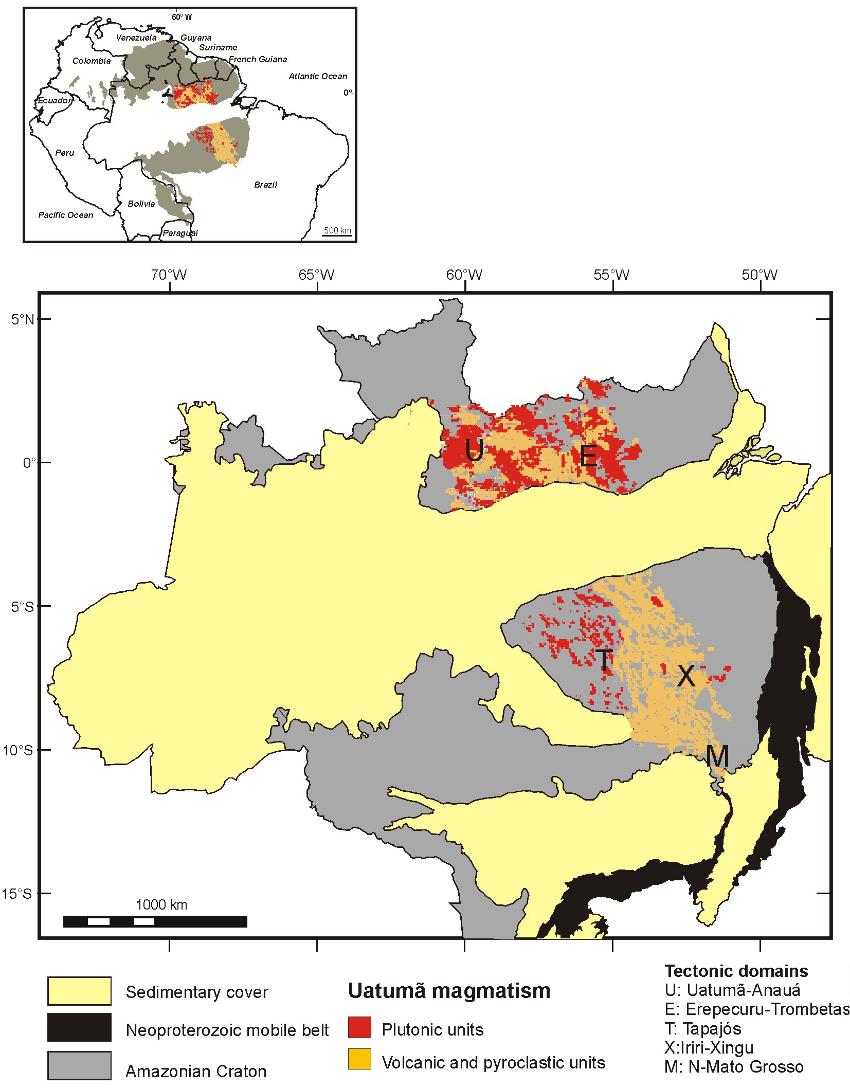
Figure 1 Schematic geological map showing the distribution of the Uatumã LIP in northern Brazil.
Geology and geochronology
The Uatumã LIP covers parts of several tectonic domains of the Amazonian Craton in Brazil, named Uatumã-Anauá, Erepecuru-Trombetas, Tapajós, Iriri-Xingu and N-Mato Grosso (Fig. 1). Considering the extent of the Uatumã magmatism, the isotopic dataset of zircon U-Pb and Pb-Pb ages and Sm-Nd data is still limited, with only a few tens of results available (Table 1, Fig. 2). Nevertheless, the data consistently show that the magmatism spanned in time from 1901 Ma to 1861 Ma, with most of the ages occurring in the 1880-1890 Ma interval (Orosirian period). In addition, the Sm-Nd model ages (TDM) are predominantly Rhyacian and Archean and the εNd parameter shows predominantly negative values, indicating mostly a crustal origin for the rocks.
Table 1 – Geochronological and Nd isotope data of the Uatumã magmatism
|
|
|
|
|
|
|
|
|
|
|
|
|
|
|
|
|
|
|
|
|
|
|
|
|
|
|
|
|
|
|
|
|
|
|
|
|
|
|
|
|
|
|
|
|
|
|
|
|
|
|
|
|
|
|
|
|
|
|
|
|
|
|
|
|
|
|
|
|
|
|
|
|
|
|
|
|
|
|
|
|
|
keys
G: Group, Fm: Formation, I.S.: Intrusive Suite, na: not available
methods: E: Pb evaporation, S: U-Pb SHRIMP; L: U-Pb LA-ICP-MS
references: 1: Reis et al. (2006 and references therein); 2: Barreto et al. (2012a); 3: Vasquez et al. (2008 and references therein); 4: Juliani and Fernandes (2010); 5: Rocha et al. (2012)
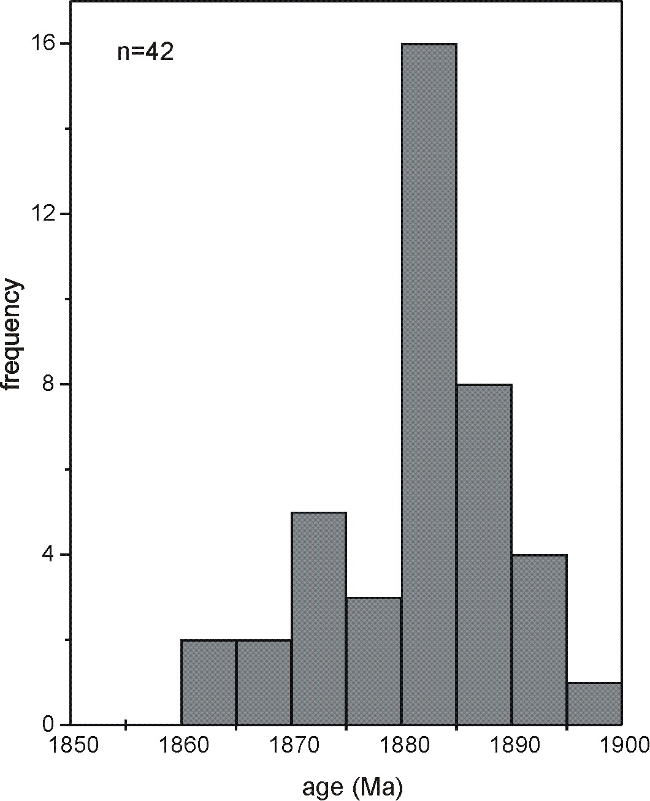
Figure 2 Frequency histogram showing the age distribution of volcanic and granitoid rocks of the Uatumã magmatism (references in the text and Table 1).
Uatumã-Anauá domain
The Uatumã-Anauá domain (Reis and Fraga, 2000; Reis et al., 2003) comprises widespread granitic magmatism generated in at least four events (2.03 Ga, 1.97-1.96 Ga, 1.90-1.87 and 1.81 Ga), including local preserved poly-deformed metasedimentary rocks (NW-SE and NE-SW foliations) of greenschist to amphibolite facies conditions. The acid to intermediate volcanic rocks and the 1.90-1.87 Ga granites are related to the Uatumã event.
The Uatumã-Anauá domain (Fig. 1) has been subdivided into northern and southern subdomains (Almeida, 2006; Almeida et al., 2002; Reis et al., 2006). The northern area comprises an older terrain represented by magmatic arc (2.03-1.97 Ga) and collisional (1.96 Ga) granitoids, including arc-related basins, located only in southeastern Roraima to southern Guyana and northwestern Pará. The southern area occurs in the southeastern Roraima - southernmost Guyana region to northeastern Amazonas (and probably in northwestern Pará), showing post-collisional rocks with no regional deformation and metamorphic features, represented by granitoids (1.90-1.87 Ga), coeval volcanic rocks and locally with charnockitoids.
The Uatumã volcanic rocks from southeastern Roraima are mainly dacites, rhyodacites, rhyolites, tuffs, andesites (Figs. 3A and 3B) and minor basalts, (CPRM 1999, Costi et al., 1984). In the Jatapu region the volcanism shows a high-K calc-alkaline geochemical pattern, similar to the coeval granitoids of the Água Branca Suite (Reis et al., 2000; Almeida, 2006). Dacite and rhyolitic tuff recorded zicon Pb-evaporation ages of 1893 Ma, including inheritances of 1966 Ma (Macambira et al., 2002; Almeida, 2006). In Brazil, the Jatapu volcanics are grouped in the Iricoumé Group, which correlates in Guyana with the Kuyuwini Group.
Similarly, the type-area of Uatumã volcanism, located in northeastern Amazonas (Uatumã river basin), is represented by rhyolites, dacites, quartz trachytes, quartz andesites, andesites, tuffs, ignimbrites and granophyres and subvolcanic rocks (Figs. 3C to 3F) of different compositions. In this region, the Iricoumé Group also shows calc-alkaline affinity (CPRM, unpublished data). However, in the western (Canoas region) and northern (Pitinga region) areas, several authors have identified rocks of the Iricoumé Group with chemical characteristics (e.g. low MgO/FeO* ratios, high SiO2 and HFSE contents) compatible with A-type associations (Mapuera Suite, 1.89-1.87 Ga, CPRM 2003, Valério et al. 2009, Ferron et al., 2010, Marques 2010, Pierosan et al. 2011).
In the Pitinga region, Ferron et al. (2010) defined three formations in the Iricoumé Group (Fig. 3G): (1) intermediate (Divisor Formation; 1897 ± 2 Ma, zircon Pb-evaporation), (2) acid (Ouro Preto Formation; 1881 ± 2 Ma and 1886 ± 6 Ma, zircon Pb-evaporation) and (3) pyroclastic (Paraíso Formation; 1890 ± 2 Ma, zircon Pb-evaporation) units. All units show A-type chemistry, and have been related to a caldera setting. However, to date, there is no criterion for a definitive establishment of the stratigraphic succession for these formations, and the interpretation of the intermediate unit with A-type chemistry remains debatable.
Valério et al. (2009) identified subvolcanic rocks (epizonal rhyolites; 1883 ± 4 Ma, zircon Pb-evaporation) in the outer borders of A-type Mapuera granitoid plutons, nearby to occurrences of coeval acid-pyroclastic Iricoumé type rocks (1896 ± 7 Ma, zircon Pb-evaporation). These rocks show transitional contacts and the volcanic rocks have been affected by narrow NW-SE-trending dextral shear zones or cataclastic zones, under (lower) greenschist metamorphic conditions, locally generating phylonites and metavolcanic rocks (Fig. 3H, CPRM, unpublished).
Volcanic rocks correlated to the Iricoumé Group have also been described in the southernmost of Guyana. These volcanic rocks form the Kuyuwini Group, cropping out as inliers, represented by slightly metamorphosed rhyodacite to dacite lavas and tuffs with SiO2 of 67.6% to 74.8%, also genetically related to intrusive members. The Kuyuwini Group shows elongate and narrow E-W-trending bodies.
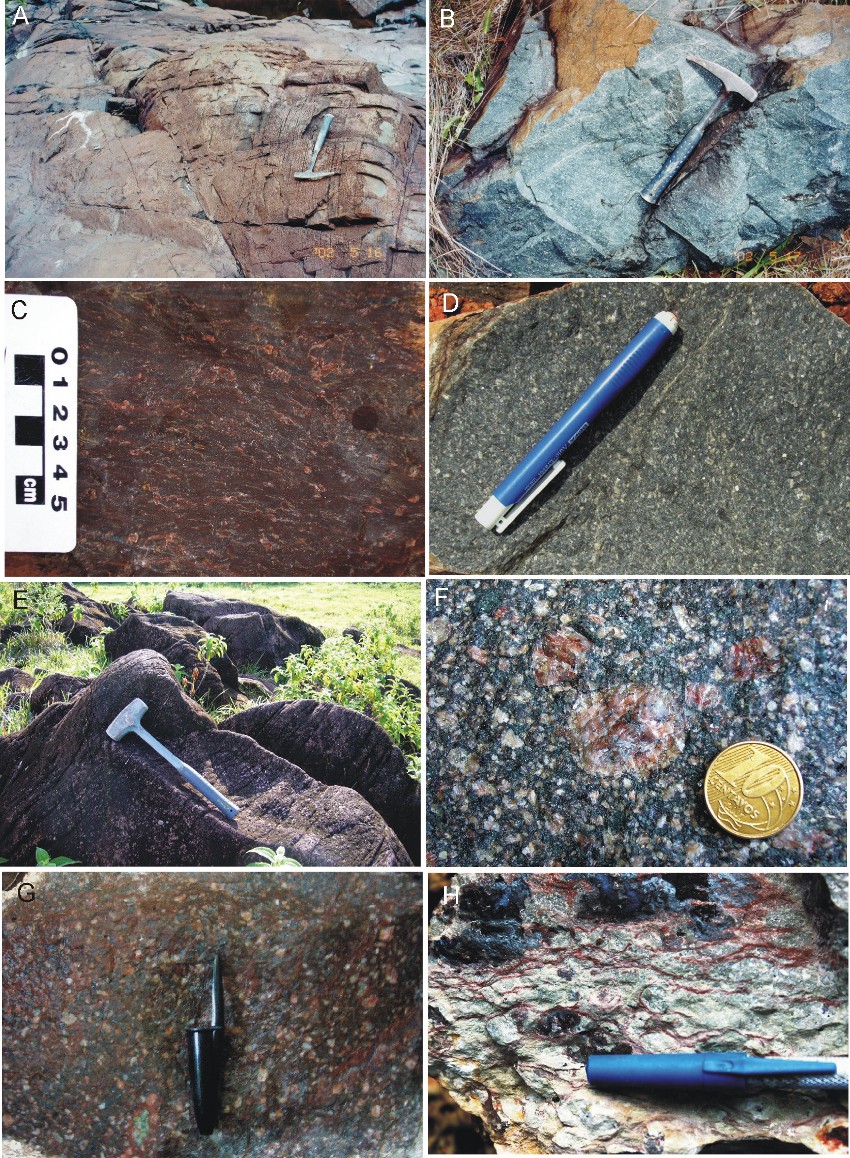
Figure 3 Images of Uatumã rocks from the Uatumã-Anauá domain. (A) Rhyolite tuff with subvertical bedding, crosscut by predominantly NE-SW fracture system. (B) Porphyritic andesite showing parallel epidote and carbonate veins. (C) Reddish rhyolitic crystal tuff, showing N40°W-trending, vertical bedding. (D) Grey-greenish porphyritic andesite with crypto-crystalline matrix. (E) Field aspect of ignimbrites and rhyolitic tuffs of the Iricoumé Group with steeply dipping bedding. (F) Fine-grained porphyritic granite associated with rhyolites and tuffs. (G) Porphyritic rhyolite showing lithophysae filled by epidote and chlorite. (H) Mylonitic volcanic rock.
Erepecuru-Trombetas domain
The Erepecuru-Trombetas (Fig. 1) domain is probably the least known, in terms of geology, among the domains described here, since it is located in a forested area with very difficult access. The basement of this domain is composed of gneisses and granitoids and possibly by greenstone belt sequences of supposed Archean age, further affected by Paleoproterozoic events. All these units have been mapped mostly by remote sensing (Vasquez et al., 2008).
The plutonic rocks in this domain are related to the Água Branca and Mapuera intrusive suites. The Água Branca suite is composed of metaluminous, high-K, calc-alkaline granitoids. The Mapuera suite is composed of pinkish monzogranites to alkali feldspar granites, locally presenting granophyric and rapakivi varieties. Geochemically, the Mapuera suite comprises weakly aluminous A-type rocks (Vasquez et al., 2008 and references therein).
The Iricoumé Group includes the volcanic and pyroclastic rocks of the domain (Fig. 4). The pyroclastic rocks are predominant and comprise ignimbrites, rheoignimbrites, tuffs and lapilli tuffs. These rocks show well-preserved primary textures and structures (Fig. 4), such as magmatic flow, convolute folding and bedding (Vasquez et al., 2008, Barreto et al., 2012a). The rocks also exhibit features that are diagnostic of deposition under high temperature, such as high volume of ignimbrites, with moderate to elevated degrees of welding, abundant juvenile fragments, devitrification and structures of gas escape, all suggesting formation in a caldera-related setting (Barreto et al., 2012a). The geochemical evidence indicate that the pyroclastic rocks are trachytes, trachy-dacites, dacites and rhyolites of metaluminous to peraluminous, and high-K calc-alkaline to shoshonitic affinity (Barreto et al., 2012b).
Almeida (2006) suggests that the evolution of the Uatumã rocks occurred in an intra-continental setting and resulted from magma underplating and melting of depleted Paleoproterozoic crustal rocks coupled with additions of juvenile material.
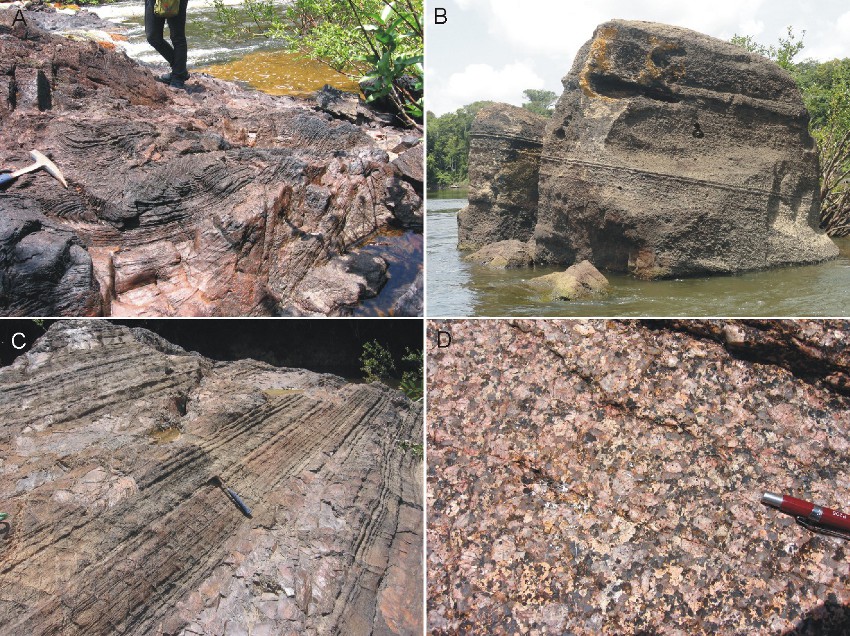
Figure 4
Fig. 4. Images of Uatumã rocks from the Erepecuru-Trombetas domain. (A) Flow folds in dacite from the Iricoumé Group. (B) Stratified pyroclastic breccia (ignimbrite) of the Iricoumé Group. (C) Regular bedding in subaerial pyroclastic fall deposits (tuff) of the Iricoumé Group. (D) Massive coarse-grained syenogranite of the Mapuera Intrusive Suite.
Tapajós domain
In the Tapajós domain (Fig. 1), the Uatumã rocks were deposited over, and intruded into, Rhyacian (1890-2033 Ma) basement associations made of amphibolite-facies gneisses, a metavolcano-sedimentary sequence of predominantly greenschist facies and several generations of more or less metamorphosed granitoid suites. All these units have been deformed at variable intensities by ductile and late brittle-ductile NW-SE-trending shear zones (Klein et al., 2001).
The Uatumã magmatism is represented by the Iriri Group and, a few granitoid units and, possibly, the Bom Jardim Formation. The volcanic and associated rocks of the Iriri Group are exposed mostly in the eastern portion of the domain. Rhyolites and dacites are predominant rocks in addition to felsic pyroclastic and epiclastic rocks. The volcanic flows show, in general, porphyritic varieties, with rounded quartz phenocrysts and tabular to irregular feldspar phenocrysts (Fig. 5). Biotite and hornblende may also occur as phenocrysts. The rhyolites have alkaline metaluminous signature consistent with that of within-plate rocks. The pyroclastic association comprises ignimbrites, volcanic breccias, conglomerates, felsic tuffs and volcanogenic sandstone and siltstone (Fig. 5). This association is interpreted to have been deposited in continental lakes near volcanic centers (Bahia and Quadros, 2000). The Bom Jardim Formation, composed mainly of high-K calc-alkaline to shoshonitic andesites and dacites, is considered to be coeval to the Irii Group.
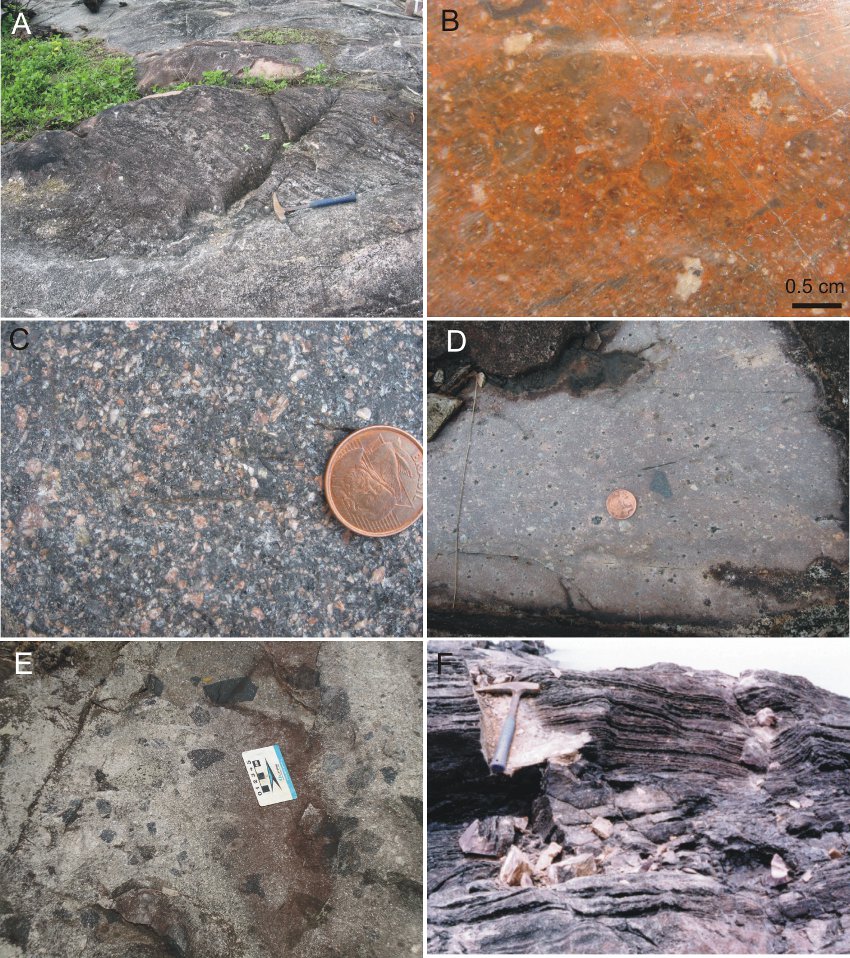
Figure 5 Images of Uatumã rocks from the Tapajós domain. (A) Outcrop of rhyolite of the Iriri Group with flow structure in contact with a massive pink granite of the Maloquinha Suite at the top. (B) Rhyolite with rounded quartz phenocrysts. (C) Rhyolite with quartz and K-feldspar phenocrysts. (D) Ignimbrite. (E) Breccia with irregular fragments of rhyolite porphyry. (F) Bedded volcanogenic sandstone (from Vasquez et al., 2008).
Juliani et al. (2005) proposed a complex set of volcanic structures and facies with the dacite-andesite flows of the Bom Jardim Formation representing the pre-caldera volcanism. Rocks of this phase have been subsequently overlain by the caldera-related sequences with ash flow tuffs, rhyolitic flows, and epiclastic volcanic rocks of the Iriri Group. This sequence, in turn, has been partly again covered by volcanoclastic and epiclastic deposits that made up the intracaldera facies. Post-caldera rocks have been formed mainly in rhyolitic composite volcanoes and domes, in which remains of radiating lava flows, crystal and welded tuffs, and breccias have been identified.
Among the Uatumã granitoids, the Maloquinha Intrusive Suite is the predominant suite in the Tapajós domain, forming stocks and batholiths broadly oriented to NE-SE. The suite is composed mainly of syenogranite and alkali feldspar granite, with subordinated monzogranite and rare quartz syenite and quartz monzonite. Biotite-bearing granites tend to have pinkish colors, whereas hornblende-bearing varieties are grayish. Locally, some granites present hastingsite, edenite or arfvedsonite and riebeckite (Vasquez et al. 2008 and references therein). The granites are metaluminous to peralkaline and have chemical characteristics typical of A-type granites (Lamarão et al. 2002, Vasquez et al. 2002).
There is a general agreement that the plutonic rocks are slightly younger than the volcanic counterparts (Vasquez et al., 2008 and references therein) and at least locally, field relationships support this interpretation (Fig. 6).
The Nd isotopic record shows TDM model ages in the range of 2.34 to 2.45 Ga, with εNd values of -1.3 to -3.0. These values indicate contribution of Archean crust in magma genesis (Vasquez et al., 2008).
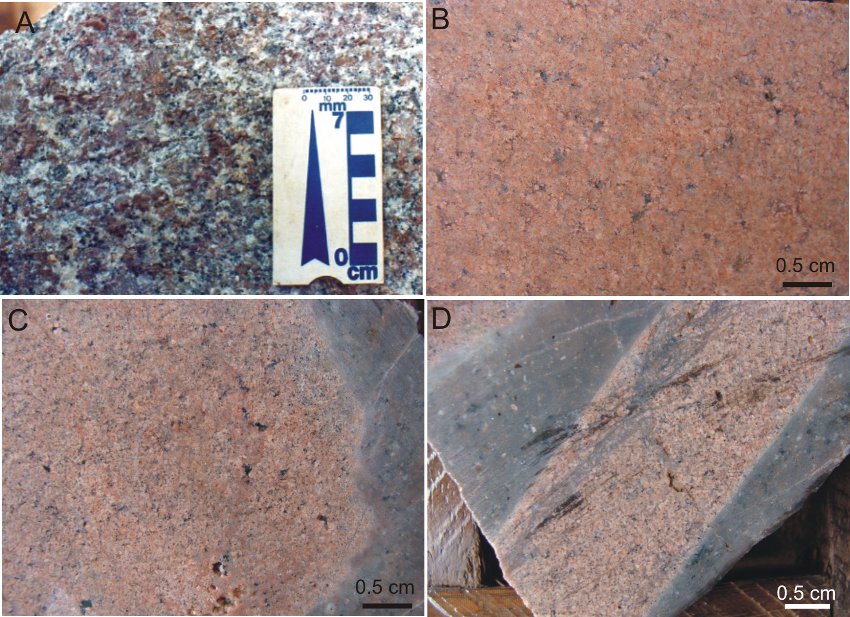
Figure 6 Coarse-grained (A) and fine-grained (B) syenogranites of the Maloquinha Intrusive Suite. (C) and (D) show contact relationships between the Uatumã volcanic and granitoid rocks.
Iriri-Xingu domain
The Iriri-Xingu domain (Fig. 1) is dominated by the volcano-plutonic associations correlated to the Uatumã magmatism in addition to sedimentary sequences of continental rifting. Basement units are scarce and the volcano-plutonic rocks show moderate to strongly negative εNd values, from -6.3 to -11.6 and Archean TDM model ages ranging from 2.60 to 3.13 Ga (Vasquez et al., 2008). These isotopic features are in clear contrast with those observed in the Tapajós domain.
Few studies are available concerning this domain and they are concentrated in the São Félix do Xingu region, in the eastern portion of the domain. For this region, Juliani and Fernandes (2010) have identified two volcanic sequences. The lower Sobreiro Formation is composed predominantly of andesitic and dacitic lava flows and associated volcaniclastic facies and subordinate pyroclastic deposits. This formation shows subduction-related chemical characteristics, with metaluminous, transitional high-K calc-alkaline to shoshonitic affinity (Fernandes et al., 2011). However, Juliani and Fernandes (2010) interpreted the eruption style to be similar to those of Continental Flood Basalt Provinces, including rare scutulum-type lava shields. The upper Santa Rosa Formation (formerly Iriri Formation) is the predominant unit. It is composed of voluminous ignimbrites with subordinate ash-fall tuff, crystal tuff, lapilli tuff, co-ignimbritic breccias, rhyolitic dikes and domes, and associated granitic porphyries and equigranular granitic intrusions. The dikes of ignimbrite and rhyolite show vertical flow structures (Julinai and Fernandes, 2010). The unit is metaluminous to peraluminous, transitional between the subalkaline and alkaline series, and compatible with within-plate A-type magmatism (Fernandes et al., 2011). According to Juliani and Fernandes (2010), the Santa Rosa Formation was produced by multi-cyclic explosive and effusive episodes associated with large fissures (Fig. 7). This model differs from those attributed to other Uatumã regions of the Amazonian craton, which are characterized by the predominance of A-type volcanism and coeval granites. Juliani and Fernandes (2010) suggest that this origin is similar to what is described for the Cenozoic Sierra Madre Occidental ignimbrite province.
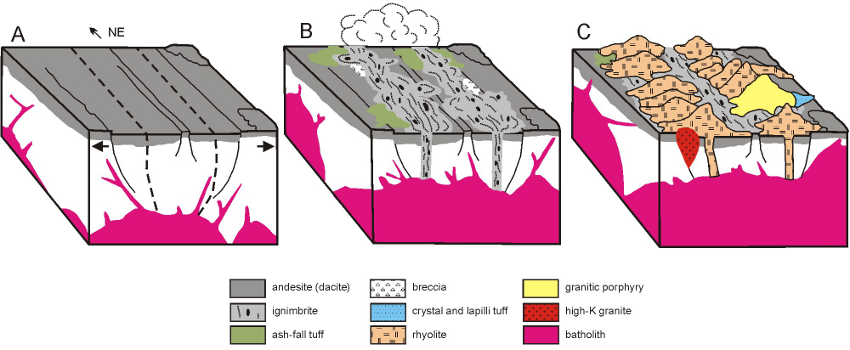
Figure 7 Sketches (not to scale) modified from Juliani and Fernandes (2010) showing the phases of development of the Uatumã magmatism in the São Félix do Xingu region (Iriri-Xingu domain). (A) Craton-scale crust extension, formation of batholithic magma chambers and deposition of the basal Sobreiro Formation. (B) Explosive volcanism and formation of large volumes of ignimbrites. (C) Extrusion of rhyolite forming domes and late intrusion of granite and granitic porphyries.
N-Mato Grosso domain
In the northern Mato Grosso domain (Fig. 1) the Uatumã magmatism is also related to the acid to intermediate effusive and pyroclastic rocks of the Iriri Group and to the Rio Dourado Intrusive Suite (Barros et al., 2011; Rocha et al., 2012).
As part of the Iriri Group in this domain Rocha et al. (2012) described a 2 km long and 250 m wide dome of acid to intermediate lavas of 1878 ± 12 Ma. The dome has a porphyritic hypabyssal core with plagioclase and biotite phenocrysts. The core changes laterally to an autoclastic pumice- and shard-rich facies with ignimbrites and rheoignimbrites showing mingling textures, and porphyritic to glomeroporphyritic textured rocks, with evidence of pumice collapse. The external facies shows flow structures. The rocks are metaluminous to peraluminous, high-K calc-alkaline successions with “post-collisional” affinity and negative Ta-Nb anomalies. Negative εNd values and depleted mantle model ages of 2.5-2.6 Ga indicate strong participation of Archean crustal material in the magma genesis. Rocha et al. (2012) suggested that the Uatumã magmatism in this part of the Amazonian Craton was formed by melting of the lithospheric mantle that was previously modified by subduction events, with subsequent magmatic differentiation.
The Rio Dourado Intrusive Suite is composed of oxidized, A-type biotite-granites showing negative Nb-Y anomalies, εNd ranging from -3 to -10 and TDM model ages of 2.62 to 2.84 Ga (Barros et al., 2011). According to the same authors, underplating of mafic magmas allowed the melting of Archean crust to generate the magmas.
Metallogenesis
The known metallogeny of the Uatumã LIP is mainly related to fault-hosted gold mineralization and granite-related tin deposits.
The Pitinga mine, in the Uatumã-Anauá domain, is one of the main tin producers in Brazil. The ore is hosted in granites, greisens and syenites of the Mapuera Suite that intruded the volcanic rocks of the Iricoumé Group. The deposit holds resources of 266.7 Mt of ore grading 0.168% Sn, 0.217% Nb2O5 and 0.027% Ta2O5.
In the Erepecuru-Trombetas domain artisanal mining (the so called garimpos) of alluvial cassiterite have been recorded in areas where the Mapuera Suite and Iricoumé volcanics crop out. In the same areas, geochemical anomalies of Sn, Pb and Zn have also been reported and occurrences of gemstones (amethyst and amazonite) have been associated to pegmatites of the Mapuera Intrusive Suite (Klein and Carvalho 2008 and references therein).
The Tapajós domain holds one of the largest gold provinces in Brazil (Tapajós Auriferous Province). Most of the gold deposits are spatially associated with units older than the Uatumã magmatism, but that are closely related to the evolution of Uatumã (e.g., Parauari Intrusive Suite). However, several deposits and showings associated with Uatumã rocks have been described. The most prominent example is the high-sulfidation epithermal volcanic-hosted mineralization of the Botica deposit (Juliani et al., 2005). The author interpreted the hosting rhyolite and volcaniclastic rocks as having been formed in post-caldera volcanoes of the Iriri Group.
The Iriri-Xingu domain is historically known for its tin deposits associated with evolved granitoids of the Velho Intrusive Guilherme Suite (Klein and Carvalho, 2008 and references therein). Juliani and Fernandes (2010) also suggest a potential for gold and tin deposits in the area and described hydrothermal potassic, propylitic, sericitic and argillic alteration, in addition to silicification zones in the volcanic and volcaniclastic rocks and potassic metassomatism, propylitic and sericitic alteration, locally with anomalous gold contents, within the porphyritic intrusions. According to the authors these alteration types are similar to those found in epithermal and intrusion-related gold systems.
Concluding remarks
The ca. 1.88 Ga Uatumã magmatism meets several characteristics to be considered a Silicic Large Igneous Province (e.g. Bryan 2007, Bryan and Ernst 2008), such as:
- The areal extent and volume of the magmatic products. The province extends for more than 1,500,000 km2;
- Predominance of erupted rhyolite and ignimbrites;
- The chemical signature is predominantly of A-type magmas, but transitional and calc-alkaline associations are also described;
- The main magmatic activity occurred in an interval of 10 Ma, although in the entire province magmatism lasted at least 29 Ma;
- Magmatism took place at the end of, or immediately after, the last known orogenic (subduction) episode in each tectonic domain, which might have favored crustal melting;
- Mineral resources are mainly (epithermal) gold and tin.
Several issues are still unresolved. Zircon geochronology and Nd isotope evidence indicate that large portions of the Uatumã LIP overly Archean crust, but in some domains, such as Tapajós, the basement associations do not include Archean rocks. Probably, the province has not formed simply by large-scale taphrogenesis that marks the breakup of a Paleoproterozoic supercontinent. More likely it represents a late-tectonic event related to orogeny.
A few evolutionary (geodynamic and petrogenetic) models are under development to explain the origin of the Uatumã magmatism, including (i) mantle underplating with continental uplift (Valerio et al., 2009), (ii) formation between the latest stage of a subduction event and earliest stage of continental rift, related to the widespread taphrogenic event of 1.88 Ga recorded in most of the Amazonian Craton (Fernandes et al., 2011), (iii) melting of the lithospheric mantle, modified by previous subduction events, with subsequent magmatic differentiation (Rocha et al., 2012).
Finally, the reasons for the preservation of unmetamorphosed and well-preserved volcanic rocks of Paleoproterozoic age are not clearly understood. Juliani and Fernandes (2010) suggested relatively fast covering of the volcanic sequences by thin layers of sedimentary units and the thermo-tectonic stability of the Amazonian Craton since the Paleoproterozoic as potentially responsible for the preservation. Alternatively, preservation has occurred because, at least in part, the Uatumã rocks lie in the inner portions of a cratonic segment.
Acknowledgements
The authors thank Dr. Richard Ernst and Dr. B. Bley Brito Neves for the invitation to write this review, and Elyana Moura that kindly provided some photographs of the Iriri Group volcanics.
References
Almeida M.E. 2006. Evolução geológica da porção centro-sul do Escudo das Guianas com base no estudo geoquímico, geocronológico e isotópico dos granitóides paleoproterozóicos do sudeste de Roraima, Brasil. Doctoral Thesis, Centro de Geociências, Universidade Federal do Pará, 227p.
Almeida, M.E.; Macambira M.J.B., Faria M.S.G. de. 2002. A Granitogênese Paleoproterozóica do Sul de Roraima. In: Congresso Brasileiro de Geologia, 41, Anais..., SBG, p 434.
Bahia, R.B.C.; Quadros, M.L.E.S. 2000. Geologia e recursos minerais da Folha Caracol SB.21-X-C. Estados do Pará e Amazonas. Escala 1:250.000. Brasília: CPRM, 2000. 1 CD-ROM.
Barreto, C.J.S., Lafon, J.M., Rosa-Costa, L.T., Lima, E.F. 2012a. Vulcanismo félsico Paleoproterozoico do Grupo Iricoumé, noroeste do Pará, Domínio Erepecuru-Trombetas, Província Amazônia Central: dados de campo, caracterização petrográfica e geocronológica Pb-Pb em zircão. Geociências USP – Série Científica (in press).
Barreto, C.J.S., Lafon, J.M., Rosa-Costa, L.T., Magalhães, L.B. 2012b. Geoquímica, geocronologia Pb-Pb em zircão e Sm-Nd em rocha total do vulcanismo félsico Orosiriano do Grupo Iricoumé, Província Amazônia Central, sul do Escudo das Guianas. Congresso Brasileiro de Geologia, 46. SBG, Santos (CD-ROM).
Barros M.A.S., Pimentel M.M., Rocha M.L.B.P., Silva F.R., Padilha R.A., Dantas F.R., Moura E. 2011. A Suíte Intrusiva Rio Dourado – Um granito tipo A de 1,88 Ga – Sudeste do Craton Amazônico – Mato Grosso – Brasil. Geologia USP, Série Científica 11, 75-93.
Brito Neves, B.B. 2011. The Paleoproterozoic in the South-American continent: diversity in the geologic time. J. South American Earth Sciences 32, 270-286.
Bryan, S. 2007. Silicic large igneous provinces Episodes 30, 20-31.
Bryan, S., Ernst, R.E., 2008. Revised definition of Large Igneous Provinces (LIP). Earth-Science Reviews 86, 175-202.
Costi, H.T., Santiago, A.F., Pinheiro, S. da S. 1984. Projeto Uatumã–Jatapu. Manaus, CPRM, Relatório Final. 133p.
CPRM 1999. Programa Levantamentos Geológicos Básicos do Brasil. Roraima Central, Folhas NA.20-X-B e NA.20-X-D (integrais), NA.20-X-A, NA.20-X-C, NA.21-V-A e NA.21-V-C (parciais). Escala 1:500.000. Estado de Roraima. Manaus, 166 p. CD-ROM.
Fernandes, C.M.D., Juliani, C., Monteiro, L.V.S., Lagler, B., Misas, C.M.E. 2011. High-K calc-alkaline to A-type fissure-controlled volcano-plutonism of the São Felix do Xingu region, Amazonian craton, Brazil: Exclusively crustal sources or only mixed Nd model ages? Journal of South American Earth Sciences 32, 351-368.
Ferron, J.M.T.M., Bastos Neto, A.C., Lima, E.F., Nardi, L.V.S. Costi, H.T, Pierosan, R., Prado, M. 2010. Petrology, geochemistry, and geochronology of Paleoproterozoic volcanic and granitic rocks (1.89–1.88 Ga) of the Pitinga Province, Amazonian Craton, Brazil. Journal of South American Earth Sciences 29, 483-497.
Juliani, C., Fernandes, C.M.D. 2010. Well-preserved Late Paleoproterozoic volcanic centers in the São Félix do Xingu region, Amazonian Craton, Brazil. Journal of Volcanology and Geothermal Research 19, 1671-179.
Juliani, C., Rye, R.O., Nunes, C.M.D., Snee, L.W., Correa Silva, R.H., Monteiro, L.V.S., Bettencourt, J.S., Neumann, R., Neto, A.A., 2005. Paleoproterozoic high-sulfidation mineralization in the Tapajós gold province, Amazonian Craton, Brazil: geology, mineralogy, alunite argon age, and stable-isotope constraints. Chemical Geology 215, 95-125.
Klein E.L., Almeida M.E., Vasquez M.L., Bahia R.B.C., Quadros M.L. E.S., Ferreira A.L. (orgs.). 2001. Geologia e recursos minerais da Província Mineral do Tapajós: Folhas: Vila Mamãe Anã (SB.21-V-D), Jacareacanga (SB.21-Y-B), Caracol (SB.21-X-C), Vila Riozinho (SB.21-Z-A) e Rio Novo (SB.21-Z-C). Estados do Pará e Amazonas. Escala 1:500.000. Nota explicativa e mapas, CPRM, Brasília. [CD-ROM].
Klein, E.L., Carvalho, J.M.A. 2008. Recursos minerais. In: Vasquez, M.L., Rosa-Costa, L.T. (Eds) Geologia e Recursos Minerais do Estado do Pará: Sistema de Informações Geográficas – SIG: texto explicativo dos mapas Geológico e Tectônico e de Recursos Minerais do Estado do Pará. Escala 1:1.000.000, Belém, CPRM, p. 217-262.
Lamarão, C.N., Dall’Agnol, R., Lafon, J.M., Lima, E.F. 2002. Geology, geochemistry, and Pb-Pb zircon geochronology of Paleoproterozoic magmatism of Vila Riozinho, Tapajós Gold Province, Amazonian Craton, Brazil. Precambrian Research 119, 189-223.
Macambira, M.J.B., Almeida, M.E., Santos, L.S. 2002. Idade de Zircão das Vulcânicas Iricoumé do Sudeste de Roraima: contribuição para a redefinição do Supergrupo Uatumã. In: Simpósio Sobre Vulcanismo Ambientes Associados, 2, 2002, Belém. Anais... p.22,.
Marques, S.N.S. 2010. Geologia, geoquímica e geocronologia Sm-Nd de rochas vulcânicas do Grupo Iricoumé, sul do Escudo das Guianas, Presidente Figueiredo (AM). Unpub. MSc Dissertation, Universidade Federal do Amazonas.
Pierosan, R., Lima, E.F., Nardi, L.V.S., Campos, C.P., Bastos Neto, A., Ferron, J.M.T.M., Prado, M. 2011. Paleoproterozoic (_1.88Ga) felsic volcanism of the Iricoumé Group in the Pitinga Mining District area, Amazonian Craton, Brazil: insights in ancient volcanic processes from field and petrologic data. Annals of the Brazilian Academy of Sciences 83, 921-937.
Reis N.J., Fraga L.M.B. 2000. Geologic and tectonic Framework of Roraima State - Guiana Shield. International Geological Congress, 31, Rio de Janeiro, Expanded Abstract.
Reis N.J., Faria, M.S.G., Fraga, L.M.B., Haddad, R.C. 2000. Orosirian calc-alkaline volcanism and Orocaima event in the northern Amazonian craton, eastern Roraima state, Brazil. Revista Brasileira de Geociências 30, 380-383.
Reis N.J., Fraga L.M., Faria M.S.G., Almeida M.E. 2003. Geologia do Estado de Roraima, Brasil. In: F. Rossi, L. Jean-Michel, M.L. Vasquez (eds). Geology de la France 2-3-4, 121-134.
Reis, N.R., Almeida, M.E., Ferreira, A.L., Riker, S.R. (org.). 2006. Geologia e Recursos Minerais do Estado do Amazonas. Sistema de Informações Geográficas 1:1.000.000. CPRM, Manaus, 144p.
Rocha, M.L.B.P., Barros, M.A.S., Lima, E.F., Pierosan, R. 2012. Paleoproterozoic Domo of Lava from Iriri Group – Sonho Meu Farm – Northeast of Mato Grosso, Amazon Craton: geology, geochemistry, and geochronology. Revista Brasileira de Geociências 42, 471-488.
Valério, C.S., Souza, V.S., Macambira, M.J.B. 2009. The 1.90–1.88 Ga magmatism in the southernmost Guyana Shield, Amazonas, Brazil: Geology, geochemistry, zircon geochronology, and tectonic implications. Journal of South American Earth Sciences 28, 304-320.
Vasquez, M.L., Klein, E.L., Ricci, P.S.F. 2002. Granitoides pós-colisionais da porção leste da Província Tapajós. In: Klein, E.L., Vasquez, M.L., Rosa-Costa, L.T. (Eds) Contribuições à Geologia da Amazônia 3, 67-84,
Vasquez, M.L., Rosa-Costa, L.T., Silva, C.M.G., Klein, E.L. 2008. Compartimentação tectônica. In: Vasquez, M.L., Rosa-Costa, L.T. (Eds) Geologia e Recursos Minerais do Estado do Pará: Sistema de Informações Geográficas – SIG: texto explicativo dos mapas Geológico e Tectônico e de Recursos Minerais do Estado do Pará. Escala 1:1.000.000, Belém, CPRM, p. 39-112.
